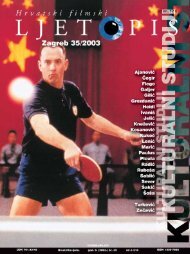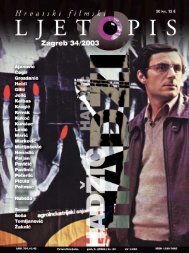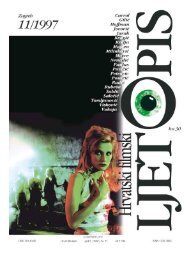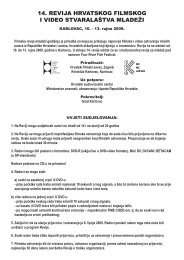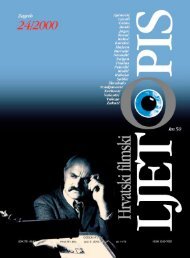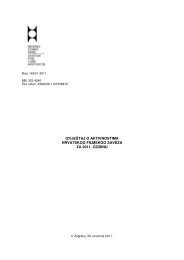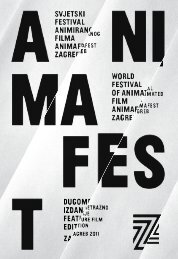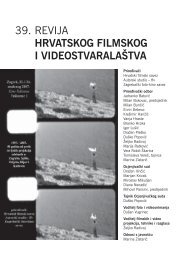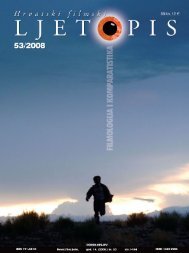Hrvatski filmski ljetopis, broj 56 (2008) - Hrvatski filmski savez
Hrvatski filmski ljetopis, broj 56 (2008) - Hrvatski filmski savez
Hrvatski filmski ljetopis, broj 56 (2008) - Hrvatski filmski savez
Create successful ePaper yourself
Turn your PDF publications into a flip-book with our unique Google optimized e-Paper software.
hfl_<strong>56</strong>-q6.qxp <strong>2008</strong>-12-18 15:22 Page 167<br />
Sa`eci Summaries<br />
TEORIJSKE TEME: MEDIJ FILMA<br />
Noël Carroll<br />
Zaboravi na medij!<br />
UDK: 791.31<br />
Pojam filmskog medija igrao je sredi{nju ulogu u intelektualnoj povijesti<br />
filma. Bio je glavnim `ari{tem filmske teorije od ranoga 20. stolje}a sve do<br />
Christiana Metza. Ta je ideja ve}inom imala legitimacijsku funkciju. Za film<br />
kao umjetnost zalagalo se tako da se tvrdilo kako je film poseban medij,<br />
kako on ima vlastit raspon svojstava i djelovanja, {to mu daje vlastito mjesto<br />
u sustavu umjetnosti. Na ovu se raspravu, nadalje, nadovezala druga,<br />
nedavnija. Kako su u SAD-u osnovani <strong>filmski</strong> odsjeci, shva}anje da je <strong>filmski</strong><br />
medij jedinstven i da ima vlastite zakone uskrslo je kao argument u prilog<br />
uspostavljanja filmskog programa nastave. Jer ako je film jedinstven<br />
umjetni~ki oblik s vlastitim zakonima, tada on tra`i vlastite esteti~are. Ako<br />
je film jedinstven umjetni~ki oblik, tada je on ujedno i jedinstven predmet<br />
studija. Naravno, nisu oni izmislili tu ideju; naslijedili su je najve}im dijelom<br />
od esteti~ara 18. i 19. stolje}a. Jer i prije pojave filmskog izuma ve} je<br />
na{iroko bila rasprostranjena ideja da svaki umjetni~ki oblik ima svoj razlikovni<br />
medij, medij koji ga ~ini razli~itim od drugih umjetni~kih oblika te<br />
uvjetuje zakone promatranog oblika. Posrijedi je bila op}a teorija umjetnosti;<br />
<strong>filmski</strong> teoreti~ari su je zapravo samo primijenili na slu~aj filma. Za{to<br />
je ta teorija tako ukorijenjena? ^ini se, naime, da ona ima iza sebe prili~an<br />
<strong>broj</strong> empirijskih svjedo~anstava. Ova teorija pretpostavlja da svaki medij<br />
ima jedinstvenu prirodu i da tu prirodu prati niz zakona. Svaki <strong>filmski</strong> teoreti~ar<br />
ne samo da je identificirao prirodu i zakone medija, nego je odmah<br />
pre{ao na navo|enje uspjeha i proma{aja {to ili odgovaraju relevantnim zakonima,<br />
tendencijama, smjerovima kako su ih teoreti~ari prognozirali, ili ih<br />
pak naru{avaju. Tako se jedinstven medijski obzor doimao ljude kao vrlo<br />
uzbudljiva i bogata ideja. Ne samo da je obe}avao kako da se razlikuju<br />
umjetni~ki oblici, i pritom, kako da se legitimira pojava novih oblika (poput<br />
filma), nego je tako|er obja{njavao za{to su neka djela proma{aji, a druga<br />
uspjela. Me|utim, kako je dobro poznato, niti jedan prijedlog koji se odnosi<br />
na jedinstvenost bilo kojeg medija nije bio imun na protuprimjere. Naime,<br />
ono {to se misli frazom »umjetni~ki medij« vrlo je rasplinuto, povremeno<br />
se odnosi na fizi~ku tvar od koje su konstruirana umjetni~ka djela,<br />
ponekad na oru|a koja se koriste pri sa~injavanju djela, a ponekad na formalne<br />
elemente oblikovanja {to su na raspolaganju umjetnica u sklopu dane<br />
prakse. Kad je film u pitanju, ako mislimo pod medijem na temeljnu tvar<br />
od kojeg se izra|uju filmske slike, prvi je na{ impuls da ka`emo kako je<br />
<strong>filmski</strong> medij o~igledno filmska vrpca sa stanovitom fotografskom emulzijom.<br />
Ali »treptavi filmovi«, poput Kubelkina Arnulf Rainera, mogu biti sa-<br />
~injeni od smjene prozirnog i crnog blanka, bez ikakve fotografske emulzije.<br />
Uz to, na praznu vrpcu se mo`e crtati i to projicirati. [tovi{e, u na~elu,<br />
video se mo`e dovesti do takva stupnja visoke rezolucije da video-slika postaje<br />
nerazlu~iva od filmske, ili, se mo`e dovesti barem do stupnja na kojem<br />
ve}ina nas ne}e imati nikakvih problema da zove filmom komercijalno narativno,<br />
igrano djelo koje je napravljeno na visokorazlu~ivom videu. I, naravno,<br />
kad bi film mogao biti napravljen na magnetiziranoj vrpci, film bi dijelio<br />
medij s glazbom. Kad pomi{ljamo na <strong>filmski</strong> medij u odrednicama oru-<br />
|a {to se tipi~no koriste u izradi filma, zasigurno }e nam pasti na pamet kamere.<br />
Ali, kao {to je prethodni primjer treptaju}eg filma upozorio, film se<br />
mo`e napraviti bez kamera, a tu mogu}nost posebno podupire postojanje<br />
grafi~kog filma. A mo`e se zamisliti filmovi koji su konstruirani posve u<br />
FILM THEORY: FILM AND MEDIUM<br />
Noël Carroll<br />
Forget the medium!<br />
The notion of the film medium has played a central role in the intellectual<br />
history of cinema. It has been a major focus of film theory from early in the<br />
twentieth century through the writings of Christian Metz. In a great number<br />
of cases, the idea has performed a legitimizing function. The case for<br />
film as art was made by arguing that film is a distinctive medium, one with<br />
its own range of properties and effects such that it warrants a place of its<br />
own in the system of the arts. The discussion, furthermore, segued into<br />
another, more recent one. As film departments were established in the<br />
United States, the notion that the film medium was unique and possessed<br />
of its own laws resurfaced as a premise in the argument for the formation<br />
of film programmes. For if film was a unique artform with its own laws,<br />
then it required its own aestheticians. If film is a unique artform, then it is<br />
a unique object of study. Of course, they did not invent this idea; they<br />
inherited it, in large part, from eighteenth- and nineteenth-century aestheticians.<br />
For before the invention of film, the idea was already widely<br />
abroad that each artform had its own distinctive medium, a medium that<br />
distinguishes it from other artforms and that determines the laws of the artform<br />
in question. This was a general theory of the arts; film theorists basically<br />
applied it to the case of cinema. Why is the theory so entrenched? The<br />
theory seemed to have a great deal of empirical evidence behind it. The theory<br />
supposes that each medium has a unique nature and that with that<br />
nature goes an accompanying series of laws. Each film theorist not only<br />
identified the nature and laws of the medium, but then went on to cite cinematic<br />
successes and failures that respectively corresponded to or violated<br />
the relevant laws, tendencies or inclinations that the theorists prognosticated.<br />
Thus, the medium uniqueness framework has frequently struck people<br />
as a very exciting and rich idea. It not only promises a way of differentiating<br />
artforms and, thereby, of legitimizing the appearance of new ones<br />
(like film), but also for explaining why some art works fail and other succeed.<br />
However, as is well known, no proposal concerning the uniqueness<br />
of any medium has been immune from counterexamples. Obviously what<br />
is meant by the phrase »artistic medium« is very vague, referring sometimes<br />
to the physical materials out of which artworks are constructed, sometimes<br />
to the implements that are used to do the constructing, and sometimes to<br />
formal elements of design that are available to artists in a given practice.<br />
With film, if we thing of the medium on the basis of the materials from<br />
which cinema images are made, our first impulse might be to say that the<br />
medium is obviously a film strip bearing certain photographic emulsion.<br />
But flicker films, like Kubelka's Arnulf Rainer, can be made by alternating<br />
clear and opaque leader, sans photographic emulsion. And one can paint on<br />
a clear film strip and project it. Moreover, in principle, video may be developed<br />
to the point where in terms of high-definition, it may be indiscernible<br />
from film, or, at least, to the point where most of us would have little trouble<br />
calling a commercial narrative feature made in fully high definition<br />
video a film. And, of course, if films can be made from magnetized tape,<br />
film would share a medium with music. If we think of the film medium in<br />
terms of the implements typically employed to make cinema, cameras<br />
undoubtedly come to mind. But as the previous examples of flicker films<br />
and painted films indicate, cinema can be made without cameras, a point<br />
167<br />
H R V A T S K I F I L M S K I L J E T O P I S <strong>56</strong>/<strong>2008</strong>.<br />
UDK: 791.31




